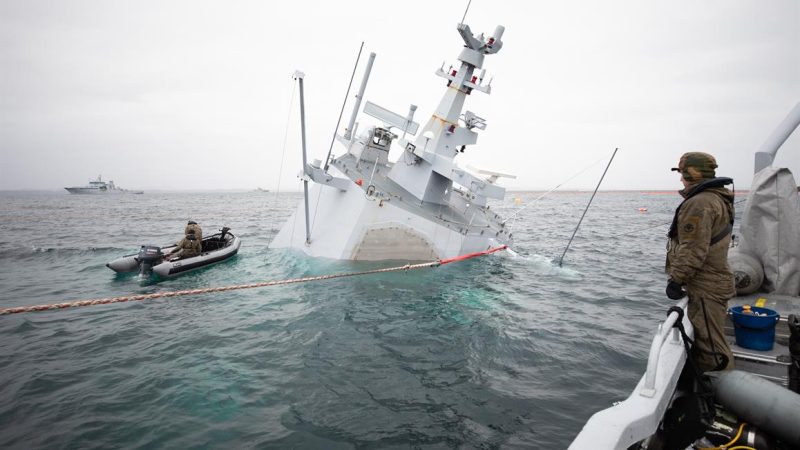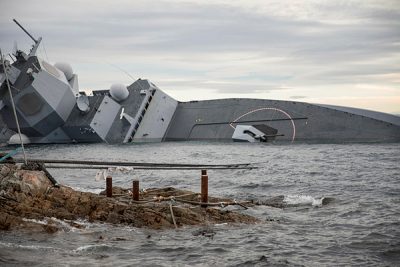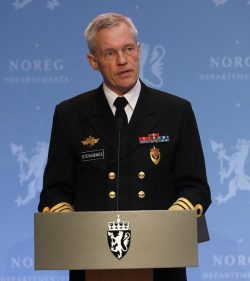A 33-year-old Naval officer went on trial in Oslo this week, charged with being responsible for a collision four years ago that led to the sinking of one of Norway’s five frigates. State prosecutors claim he was ultimately responsible, as duty officer on the bridge of the frigate, while he claims he’s being made the scapegoat in one of the Norwegian Navy’s most embarrassing accidents.

“It’s the defendant’s negligent navigation that’s to blame for the loss of the (frigate) KNM Helge Ingstad,” state prosecutor Benedikte Høgseth claimed as the officer’s trial got underway in Bergen on Monday. She maintains that as vaktsjef (duty officer) on the bridge of the frigate when it collided with a fully-laden tanker, he was responsible for the frigate and the lives of 137 people on board.
Not so, claims the duty officer’s defense attorney Christian Lundin. He points to how accident investigators have identified a string of errors and miscommunication among those involved, and blames weakness in the entire naval system surrounding the frigate. “Everything that could have gone wrong, went wrong at the same time,” Lundin claimed in court. “The duty officer is just a small part of that. Should he alone be left with the personal responsibility?”
The Helge Ingstad was on its way back to home port in Bergen after NATO exercises in the fall of 2018 when it collided with the tanker Sola TS in the dark early morning hours of November 8. The vessel, which was still relatively new and had cost more than NOK 4 billion to build, was sailing by the busy Sture oil terminal northwest of Bergen when it collided with the tanker.
Accident investigators have established, among other things, that the tanker was sailing with its floodlights still lit. That’s not unusual upon leaving a terminal, but the crew on board the frigate mistok the tanker’s lights for the terminal’s. Lundin claims the lights also made it difficult to see maritime lanterns and that factors including language problems, poor surveillance from those in charge of marine traffic in the area at the time, a lack of routines for duty officers on the frigate and insufficient use of radar all contributed to the collision.

The duty officer in charge at the time, meanwhile, received several warnings to swerve away from the approaching tanker from the pilot on board the tanker and, finally, from marine traffic controllers who desperately called for it to make a sharp turn. The frigate itself had been sailing with its own radar turned off for security reasons: Other vessels in the area couldn’t see it on their own radar and could only visually see it as “a big dark shadow.”
It’s already been established that lots of rules were broken before the frigate sank and that human error played a major role. Naval officials shielded the vessel’s crew after the sensational and expensive collision and Norway’s defense minister even publicly praised them, while criticism also flew over how the accident could have occurred and how the Navy handled it.
The frigate has since been scrapped and still hasn’t been replaced. The captain of the frigate, who was sleeping at the time of the collision, reacted publicly to the criticism at the time, while the former chief of the Navy who was ultimately in charge, Nils Andreas Stensønes, has since been promoted to head military intelligence for the defense department. The defense department itself has paid a NOK 10 million fine in connection with the frigate collision and sinking.
Four years later only the duty officer has been formally charged with “negligence” that led to the collision and “easily could have also led to loss of human life.” He faces up to three years in prison if convicted but was intent Monday on defending himself. News bureau NTB reported that he still works for the Navy and he appeared in court wearing his uniform. When asked by the judge whether he admits guilt, he responded with a firm “no.”
Earlier cases against the Norwegian coast guard, marine traffic operators, the pilot aboard the tanker and the captain involved have since been dropped for lack of evidence. The duty officer now under indictment will have five days to offer his side of the story by testifying in court. On Tuesday, all parties involved in his trial were taking a tour of another frigate’s bridge to familiarize themselves with the situation he was in at the time. More than 30 others have also been called in to testify.

Newspaper Aftenposten asked Stensønes what he thinks about only one person being charged, but Stensønes said he didn’t find it “correct” to share his personal evaluation of the indictment against the duty officer. “It’s the prosecutor’s office that has made that decision,” Stensønes told Aftenposten. “It’s important, though, that the Navy continues to take care of its employees in such situations.”
Asked what responsibility he had for the frigate collision and sinking, Stensønes responded that “as leader I of course am always responsible, that’s the way it is. Beyond that I have no comment.” Stensønes has not been called upon to testify at the duty officer’s trial.
NewsinEnglish.no/Nina Berglund

